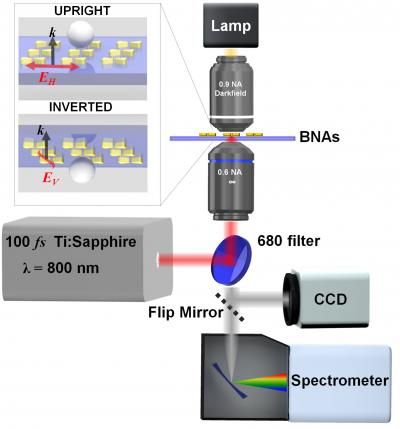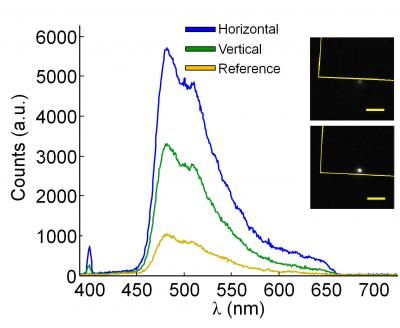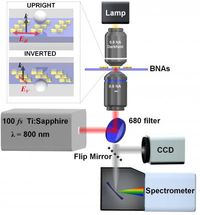Newly demonstrated capabilities of low-powered nanotweezers may benefit cellular-level studies
Low-power optical nanotweezers
Using ultra-low input power densities, researchers at the University of Illinois at Urbana-Champaign have demonstrated for the first time how low-power "optical nanotweezers" can be used to trap, manipulate, and probe nanoparticles, including fragile biological samples.

This is the experimental setup schematic showing laser source, microscope, and imaging detector and spectrometer. Inset illustrates the two different sample configurations that were explored; the red arrows correspond to the input polarization directions and the black arrows depict the propagation vector.
University of Illinois

This image shows experimentally collected spectra from the trapped fluorescent microbead-BNA system (inverted orientation) with horizontal and vertical polarization (parallel and perpendicular to the bowtie axis, respectively). The reference is taken from a microbead trapped away from the arrays in the inverted orientation. The inset image depicts the dramatic fluorescence enhancement when the particle is moved onto the array (indicated by the yellow outline). The scale bar is 5 um.
Toussaint/University of Illinois


"We already know that plasmonic nanoantennas enhance local fields by up to several orders of magnitude, and thus, previously showed that we can use these structures with a regular CW laser source to make very good optical tweezers," explains, Kimani Toussaint, Jr., assistant professor of mechanical science and engineering at Illinois. "This is exciting because, for the first time, we're showing that, the near-field optical forces can be enhanced even further, without doing anything extra in terms of fabrication, but rather simply by exploiting the high-peak powers associated with using a femtosecond (fs) optical source.
"We used an average power of 50 microwatts to trap, manipulate, and probe nanoparticles. This is 100x less power than what you would get from a standard laser pointer."
In their recent paper, "Femtosecond-pulsed plasmonic nanotweezers" published in Scientific Reports, the researchers describe how a femtosecond-pulsed laser beam significantly augments the trapping strength of Au bowtie nanoantennas arrays (BNAs), and the first demonstration of use of femtosecond (fs) source for optical trapping with plasmonic nanotweezers.
"Our system operates at average power levels approximately three orders of magnitude lower than the expected optical damage threshold for biological structures, thereby making this technology very attractive for biological (lab-on-a-chip) applications such as cell manipulation," Toussaint added. "This system offers increased local diagnostic capabilities by permitting the probing of the nonlinear optical response of trapped specimens, enabling studies of in vitro fluorescent-tagged cells, or viruses using a single line for trapping and probing rather than two or more laser lines."
"We present strong evidence that a fs source could actually augment the near-field optical forces produced by the BNAs, and most likely, other nanoantenna systems, as well. To our knowledge, this has never been demonstrated," said Brian Roxworthy, a graduate student in Toussaint's PROBE (Photonics Research of Bio/nano Environments) lab group and first author of the paper. According to Roxworthy, the demonstration of controlled particle fusing could be important for creating novel nanostructures, as well as for enhancing the local magnetic field response, which will be important for the field of magnetic plasmonics.
The paper also demonstrated enhancement of trap stiffness of up to 2x that of a comparable continuous-wave (CW) nanotweezers and 5x that of conventional optical tweezers that employ a fs source; successful trapping and tweezing of spherical particles ranging from 80-nm to 1.2-um in diameter, metal, dielectric, and both fluorescent and non- fluorescent particles; enhancement of two-photon fluorescent signal from trapped microparticles in comparison to the response without the presence of the BNAs; enhancement of the second-harmonic signal of ~3.5x for the combined nanoparticle-BNA system compared to the bare BNAs; and fusing of Ag nanoparticles to the BNAS.






















































